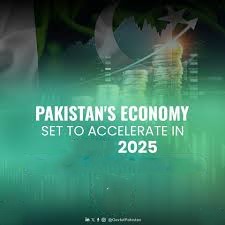Pakistan economy has been facing significant challenges in recent years, but 2025 presents an opportunity for growth and recovery. Policymakers, investors, and businesses are keenly observing the economic landscape to plan ahead. This article explores the key challenges and opportunities that will shape Pakistan’s economic outlook in 2025.
Current Economic Situation
Pakistan economy has shown mixed performance over the past decade. GDP growth has remained sluggish, largely due to structural inefficiencies and external shocks. Major industries such as agriculture, textiles, and IT play a crucial role, but inflation and unemployment remain concerns. The Pakistani rupee has faced depreciation, further exacerbating economic challenges.
Major Challenges Facing Pakistan’s Economy
1. High Inflation and Currency Depreciation
Inflation rates have surged due to rising global commodity prices and local inefficiencies. The depreciation of the Pakistani rupee against the US dollar increases import costs, making essential goods more expensive for consumers.
2. Rising Debt Burden
Pakistan’s external debt has reached alarming levels, with significant repayments due in the coming years. The country relies heavily on IMF programs and foreign loans, which can limit fiscal flexibility.
3. Energy Crisis and Power Shortages
Frequent power outages and an unreliable energy supply hinder industrial productivity. Without investment in energy infrastructure, manufacturing and exports will continue to suffer.
4. Political Instability and Governance Issues
Uncertain political conditions deter foreign investors. Effective governance, transparency, and policy consistency are crucial for economic stability.
5. Trade Deficit and Low Exports
Pakistan imports more than it exports, leading to a trade deficit. Key export sectors such as textiles need modernization and support to compete globally.
Opportunities for Economic Growth
1. CPEC and Infrastructure Development
The China-Pakistan Economic Corridor (CPEC) continues to be a game-changer, bringing investment in roads, energy, and logistics that can boost trade and industrial output.
2. Boosting Agriculture and Agribusiness
Agriculture remains the backbone of Pakistan’s economy. Investment in modern farming techniques, irrigation, and value-added agribusinesses can enhance productivity and exports.
3. IT and Digital Economy Growth
The IT sector is one of Pakistan’s fastest-growing industries. With global demand for tech services increasing, Pakistan has the potential to become a major player in software development and freelancing.
4. Renewable Energy Investments
With a growing energy crisis, investment in solar, wind, and hydropower can provide sustainable solutions and reduce reliance on expensive imported fuels.
5. Foreign Direct Investment (FDI) and Business Reforms
Government efforts to create a business-friendly environment through tax incentives, ease of doing business reforms, and industrial zones can attract foreign investors.
Government Policies and Economic Reforms
To ensure sustainable growth, Pakistan needs:
- Tax reforms to widen the tax base and reduce evasion.
- Trade policies that encourage exports through incentives and diversification.
- Investment in human capital, particularly in education and vocational training, to develop a skilled workforce.
Impact of Global Economic Trends on Pakistan
Global oil prices, inflation rates, and geopolitical shifts will significantly influence Pakistan’s economy. Strengthening trade partnerships within South Asia and the Middle East can help mitigate risks from external shocks.
Predictions for 2025 and Beyond
Economic forecasts suggest:
- GDP growth may stabilize around 4-5% if key reforms are implemented.
- Inflation could decline with better fiscal management.
- Export diversification and CPEC projects may improve economic resilience.
Conclusion
Pakistan economic future depends on addressing existing challenges while leveraging available opportunities. Policymakers must implement sound fiscal strategies, invest in key sectors, and promote investor confidence to ensure long-term growth.
For more extensive information, click here
FAQs
1. What is the projected GDP growth for Pakistan in 2025?
Experts estimate a GDP growth rate of around 4-5%, contingent on economic stability and policy implementation.
2. How will CPEC impact Pakistan’s economy in 2025?
CPEC will enhance infrastructure, boost trade, and attract foreign investments, potentially improving economic growth.
3. What steps can Pakistan take to reduce its trade deficit?
Promoting exports, reducing unnecessary imports, and investing in local industries are key steps to address the trade deficit.
4. How can Pakistan attract more foreign investment?
By ensuring policy consistency, reducing bureaucratic hurdles, and offering incentives for businesses, Pakistan can attract greater foreign investment.
5. What are the key challenges for small businesses in Pakistan?
Small businesses face challenges such as high taxation, lack of financing options, and infrastructure issues, which need policy support to thrive.


